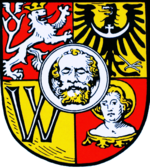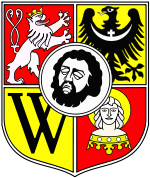- Coat of arms of Wrocław
-
The Coat of arms of the City of Wrocław is divided into quarters.
In the centre is the head of John the Baptist, patron saint of the city. The crowned lion rampant in the first (upper left) quarter represents the Kingdom of Bohemia, to which Wrocław belonged to since 1336. In the second (upper right) quarter there is the Silesian eagle which comes from the Silesian Piast eagle. The letter "W" in the third quarter stands for both "Wratislavia" (Latin name of the city) and for the name of the legendary founder of the city Wrocislaw. In the fourth quarter there is St. John the Evangelist.
Its blazon is: "Quarterly, I: Gules, a lion rampant queue fourch erect facing sinister Argent, armed and langued Or outlined Sable, crowned Or outlined Sable; II: Or, an eagle Sable charged with across its breast and wings a crescent Argent upward pointing with a crosslet Argent attached rising from the middle; III: Or, a capital letter 'W' Sable serifed; IV: head and shoulders of St. John the Evangelist gardant Argent, with youthful face and long hair Argent outlined Sable and with halo Or outlined Sable, issuant from an inverted crown Or outlined Sable. Surmounting all at center a roundel Argent, double-bordered in Sable, charged with St. John the Baptist's head Argent, with beard and hair Sable, semi-gardant turned toward the dexter."
This particular version of the arms was granted to the city in 1530 by Ferdinand I, Holy Roman Emperor.
In 1938, this coat of arms was abolished, as the Nazi authorities viewed it as too Slavic. It was replaced by a "purely German" coat-of-arms, a shield parted horizontally, with a black Silesian eagle on the top without Christian crosslet on the breast, and an Iron Cross in red field on the bottom. This was abolished after the German inhabitants were expelled by the Red Army in 1945.
Wrocław, as part of the People's Republic of Poland, changed the coat of arms again as the authorities now - ironically - considered the original version as too Germanic. It was replaced by a "purely Polish" coat of arms with a Silesian black eagle on gold and a Polish white eagle on a red field. These coat of arms were used from 1948 to 1990.
After the collapse of communism, the city decided to revert to the coat of arms of 1530, albeit in a more stylized form.
See also
References
External links and sources
Coats of arms of cities in Poland Categories:- Coats of arms of cities in Poland
- Wrocław
Wikimedia Foundation. 2010.




